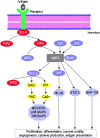Ibrutinib and novel BTK inhibitors in clinical development
- PMID: 23958373
- PMCID: PMC3751776
- DOI: 10.1186/1756-8722-6-59
Ibrutinib and novel BTK inhibitors in clinical development
Abstract
Small molecule inhibitors targeting dysregulated pathways (RAS/RAF/MEK, PI3K/AKT/mTOR, JAK/STAT) have significantly improved clinical outcomes in cancer patients. Recently Bruton's tyrosine kinase (BTK), a crucial terminal kinase enzyme in the B-cell antigen receptor (BCR) signaling pathway, has emerged as an attractive target for therapeutic intervention in human malignancies and autoimmune disorders. Ibrutinib, a novel first-in-human BTK-inhibitor, has demonstrated clinical effectiveness and tolerability in early clinical trials and has progressed into phase III trials. However, additional research is necessary to identify the optimal dosing schedule, as well as patients most likely to benefit from BTK inhibition. This review summarizes preclinical and clinical development of ibrutinib and other novel BTK inhibitors (GDC-0834, CGI-560, CGI-1746, HM-71224, CC-292, and ONO-4059, CNX-774, LFM-A13) in the treatment of B-cell malignancies and autoimmune disorders.
Figures


References
-
- McLaughlin P, Grillo-Lopez AJ, Link BK, Levy R, Czuczman MS, Williams ME, Heyman MR, Bence-Bruckler I, White CA, Cabanillas F. et al.Rituximab chimeric anti-CD20 monoclonal antibody therapy for relapsed indolent lymphoma: half of patients respond to a four-dose treatment program. J Clin Oncol. 1998;16(8):2825–2833. - PubMed
Publication types
MeSH terms
Substances
LinkOut - more resources
Full Text Sources
Other Literature Sources
Research Materials
Miscellaneous

